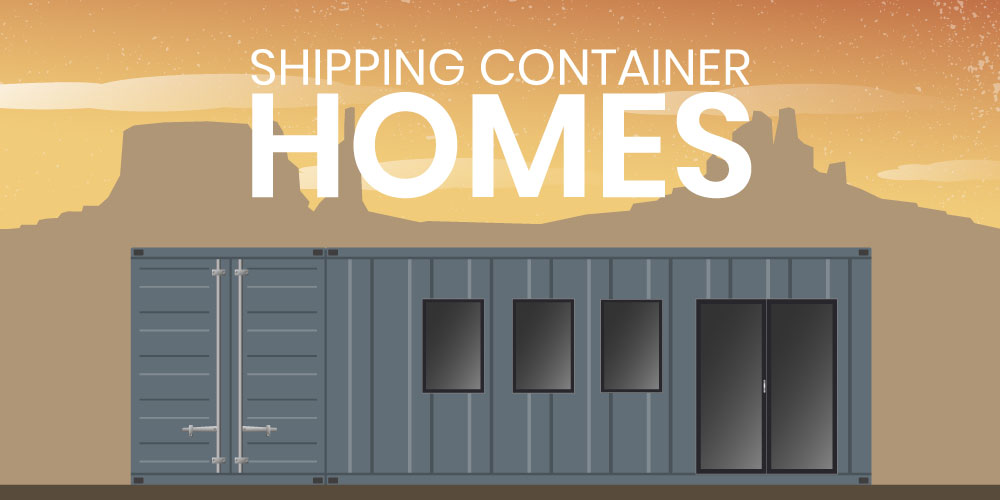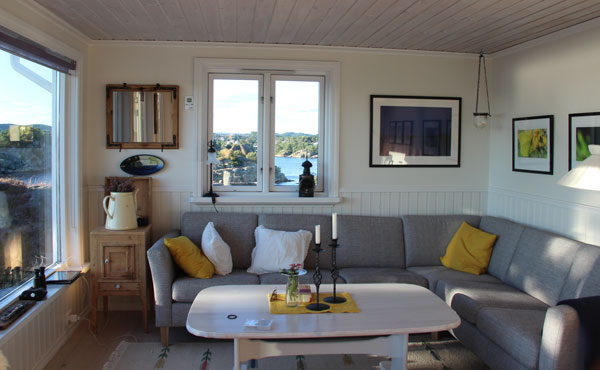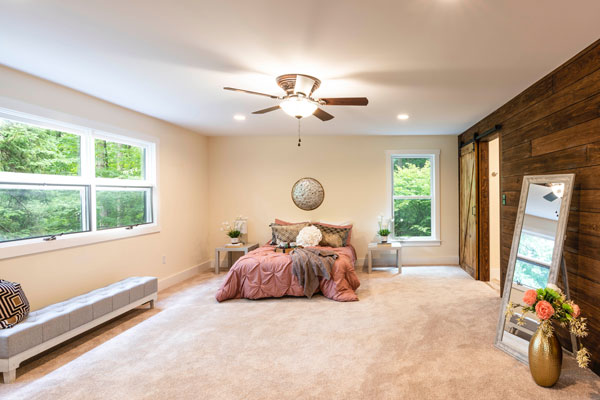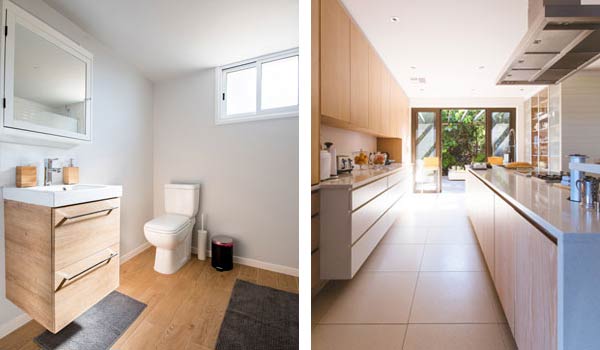 I get asked a lot about shipping container homes when people learn that I’m into tiny houses, and I do have some experience working with shipping container homes. My good friend, D.I. built his own container home here in Charlotte, using a 40-foot container. It was the first one I’d ever seen built out in person and it was neat to watch as D.I. built it over two years, learning along the way.
I get asked a lot about shipping container homes when people learn that I’m into tiny houses, and I do have some experience working with shipping container homes. My good friend, D.I. built his own container home here in Charlotte, using a 40-foot container. It was the first one I’d ever seen built out in person and it was neat to watch as D.I. built it over two years, learning along the way.
Living in a shipping container may sound a bit … unconventional. You may envision an old, rusty boxcar or simply a big metal box.

Surprisingly, shipping container homes are quite beautiful and economically friendly. Many are drawn to their affordable nature and modern lines. They do require a fair amount of work and preparation (and there are a few quirks to be aware of), but with effort, you can create a beautiful home from something ordinarily discarded and save thousands doing it.
What Is A Shipping Container Home?

If you aren’t familiar with shipping container homes, they’re quite interesting. Charlotte happens to be home to one of the largest fabricators of shipping container homes, and I was invited to take a tour of their facility. It was really eye-opening to see how much work went into prepping the containers, so they were ready to build with. The common perception is, “it’s easy because the box is already there.” I learned both from watch D.I. and from my plant tour that’s far from the truth. There’s a lot of effort that goes into turning a container into a home.
Shipping containers are big metal boxes (like a boxcar or the box atop the trailer of a semi-truck), sometimes referred to as Conex boxes. These containers are typically built overseas (usually in China) and are used to ship goods all around the world. Shipping containers are widely available, and many are used only one time on a one-way trip from China (since the U.S. receives more goods than it sends back).

These metal (aluminum or steel) Conex boxes are used to ship all types of materials—some hazardous, but mostly benign. Once they’re used and retired or put out of commission, they’re often stored near ports around the United States. Shipping containers are inexpensive to procure and readily available.
Shipping containers have been used to transport goods since the mid-1950s, but it wasn’t until 1987 that the first shipping container was patented for use as a converted home (although people used them as homes and buildings years earlier). Because the modular containers are easy to combine, there are large buildings built from multiple containers, including a mansion made of 31 containers and a hostel large enough to house 120 people!
Most people who live in shipping container homes, however, opt for the tiny house version, using one or two shipping containers as their home. Thanks to the availability, sturdiness, and modern look of Conex boxes, they are customizable.
Why Build A Shipping Container Home?

Admittedly, I’m drawn to the idea of shipping container homes. My one hesitation is that I have no experience with metalworking. I’ve never used a plasma torch or welder before. It’s definitely one of those things I want to learn on my bucket list, but from seeing people actually do it—before you build a shipping container home, you need metalwork experience.
Due to the metalwork, shipping container homes are a little more advanced in terms of building and modifying. They aren’t always the right fit for the typical hobbyist or DIYer who doesn’t have prior building skills because there is quite a bit of technical work required (the obvious metalwork, plus other skills like concrete, engineering, etc.). The big appeal of shipping container homes really comes from the modular design and the modern look.

That said, there are many other reasons why a shipping container home is an appealing option. The biggest draw of building or buying a shipping container home is that it’s often quite inexpensive. You can find single-use shipping containers for under $5,000 and you instantly have a shell to work in.
Shipping container homes are very strong and sustainable. They’re built to last with a tough exterior that holds up to hurricanes and earthquakes. It’s also nice to give life to the used containers that would ordinarily go to waste. Many shipping containers are used once and then sit empty in ports (or get melted down).
Shipping container homes are also fairly easy to transport intact. Yes, they’re extremely heavy, so they aren’t exactly a tiny house on wheels, but moving a shipping container home to a new foundation is doable without disrupting the structure of the home itself. The containers can be stacked to expand into multi-story homes or configured in interesting modular designs.
The Pros and Cons of Shipping Container Homes

There are a few drawbacks to living in a shipping container home. One of the biggest challenges is that metal is conducive to heat and cold. Shipping container homes require insulation and ventilation for comfortable living.
Unlike wood, concrete, brick, and stone, metal is a little trickier for temperature and condensation control. They are also loud in windy climates. Thermal bridging is a huge issue in a shipping container home; the metal skin acts as a heat sink, drawing the heat out in the winter and bringing the heat in during summer. This all adds up to a less efficient building and can lead to moisture and mold issues if not properly managed.

Shipping containers also require welding abilities to modify. Unlike wood and other home construction materials, you can’t simply create a window or cut a vent in your home without planning carefully. Welding takes time and is costly, so you’ll want to be cautious as you plan. It’s also a bit more difficult in remote locations because they don’t make battery-powered welding units.
Obviously, planning windows, vents, and other modifications means you need to be aware of load-bearing and structural elements before you make a change to the container. Openings cut in the skin often lead to you needing to reinforce the structure because each cut you make weakens the whole structure.
Shipping containers also require a concrete foundation or, at minimum, piers. You can’t simply put your container house on the ground unsupported and I’ve seen many novice builders attempt to skimp on their footings.
Laying a foundation takes time and adds to the expense associated with the project; it also means you need to be certain exactly how you want to plan the layout of your property. A shipping container home should be viewed as a more permanent construction (although they can be moved intact to a new foundation). It is a cost that you should make sure to budget in for expenses.

Work with a contractor or someone with previous shipping container home-building experience, especially if you’re new to the world of tiny home building. Shipping container homes tend to be one of the more advanced tiny home options. Although they’re ultimately a simple structure, there are certain quirks and issues to be aware of.
Of course, you can find pre-made shipping container structures, but they’re often quite expensive. Creating a shipping container home by yourself is less expensive, but you’ll still need to enlist the help of experts. Even to procure the shipping container and move it to your foundation is a big undertaking. You’ll need a crane to deliver the container and set it atop your foundation. Shipping containers are extremely heavy. Depending on the length (20 foot or 40 foot) they weigh between 5,000-8,000+ pounds. You aren’t going to move a shipping container yourself.
When I worked with my friend, D.I. on his 40-foot container home build, the need for welding skills was a big issue. He didn’t know how to weld or use a plasma torch at all when he started to build his container home, so modifications were a challenge for him. It was important to plan ahead so he could have a contractor do all the welding at once (rather than paying him to return over and over again).
The other challenge D.I. faced was his container home was so immobile. You really need a crane to even move it a short distance or adjust it slightly on the foundation. This means when you get the container installed, you need to be certain of the exact placement you want.

Finally, another big barrier is that local building code enforcement officials are often unfamiliar with shipping container homes. As a result, it can be tough to get the proper permits for them.
Although there are building challenges, the final look of a shipping container home is really appealing. They have a modern, architectural quality which I find really appealing if done well. They’re inexpensive, extremely durable, and are easily customized.
Here are a few reviews and honest takes on the pros and cons of living in a shipping container home:
- Why Do People Live in Shipping Container Homes? from Discover Containers
- Container Homes Pros, Cons and Cost Comparison from Build with Rise
- Pros & Cons of Shipping Container Homes + Complete Guide from Organics
How Much Does A Shipping Container Home Cost?

Shipping containers themselves, depending on size, cost anywhere from $3,000-$5,000+. It’s much less expensive to buy a shipping container that’s been used for a single ship than to buy a brand-new container. As long as you do your research and ensure the container didn’t contain any dangerous materials, the use is almost always undetectable. You can work with scratches or dents to cover them (or remove) as part of the design, even a little rust can be ground out and repainted.
The biggest mistake I see people make is not factoring in expenses of building a shipping container home to include transportation and placement of the container itself. The second biggest mistake is the foundation build, too often people skip or skimp on this step.
Even if you take the DIY route, chances are you will need to enlist expert help on factors like solar, electric (remember, metal is conductive), plumbing, and modification, especially if you don’t have much welding experience.

As I said before, because aluminum and steel are conductive, they must be insulated and ventilated carefully to prevent the buildup of condensation and to simply make living more comfortable. So, expert insulation, heating, and cooling will need to be configured into your cost as well.
That last area where I see people get tripped up is that you will also need to consider fees for permits, architectural designs, and plans. As far as permitting goes, as I said, there are many cities without much familiarity with zoning for shipping containers used as dwelling structures, so you’ll need to work with your local officials on the proper approval. This often will include hiring an engineer to work out plans to make officials feel comfortable signing off on it.
The question of cost really comes down to how much planning you will need to do, what you can DIY, and what you’ll need to outsource. Once you’ve procured the container itself, the other pieces can either add up or be done on the cheap.
Here are several outlines of storage container build-outs with pricing:
- Top 20 Shipping Container Home Designs and Their Costs from 24hPlans
- Storage Container Pricing & Options from 360MobileOffice
- Cost Breakdown of Building a Container Home from Discover Containers
As you see, the costs vary greatly depending on your plans and the level of architectural design you want to put into your shipping container home. If you’re most concerned with functionality, then a single shipping container buildout is an inexpensive tiny home option.
How to Find and Buy A Shipping Container
 If you’re ready to find and buy a shipping container home, you need to start researching the size you want. Shipping containers typically come in two standard sizes: 20 foot and 40 foot. The best containers for homes are listed as “HC” or High-Cube containers. HC containers are 9 feet “tall” (as opposed to the standard 8-foot container). That said, shipping containers come in many other sizes as well; you can find them ranging from 8-53 feet. The next most common size is 45 feet, but again, 20- or 40-foot containers are standard (and the easiest to find).
If you’re ready to find and buy a shipping container home, you need to start researching the size you want. Shipping containers typically come in two standard sizes: 20 foot and 40 foot. The best containers for homes are listed as “HC” or High-Cube containers. HC containers are 9 feet “tall” (as opposed to the standard 8-foot container). That said, shipping containers come in many other sizes as well; you can find them ranging from 8-53 feet. The next most common size is 45 feet, but again, 20- or 40-foot containers are standard (and the easiest to find).
When choosing a size, don’t forget that you’ll be building inwards. You’ll need to frame out the inside and insulate it as well. Depending on your choices for these, you could be eating into your interior by 6-8 inches off each wall.
Shipping containers are graded by condition. “A grade” means the container is good quality with a clean interior and watertight with in-tact seals. The container grades go down to “C grade,” which usually means rust is present, and the container is 10-14 years old. The prices vary by grade but for living, chances are you’ll want to pay a little more for a higher quality container.

Shipping containers are also graded by the following: “One-trippers” meaning new containers that contained only one shipment. “Certified Cargo Worthy” meaning they’ve been used for multiple shipments but are in good condition. “Wind and Watertight” (WWT) indicating they’ve been used but are still in decent condition. “As-Is” means the container may have rust, doors that don’t seal or pinholes in the metal. Containers graded “As-Is” should probably be avoided for dwellings.
The other factors to consider are the land where you plan to place your container (and if you already have a foundation or will need to pour one). You’ll need to ensure the land is accessible for large trucks or cranes so your shipping container home can be placed.
To buy shipping containers check out:
- Shipped is the biggest new and used shipping container marketplace online
- BoxHub is another big new and used shipping container marketplace
- Craigslist and eBay are also options for finding shipping container homes
Before you buy, you’ll want to review these resources and guides for buying a shipping container home as well:
- How to Buy a Shipping Container from Instructables
- 10 Things You Should Know Before Buying a Container from Off Grid World
- The Complete Guide to Buying Shipping Containers from Discover Containers
Building Your Own Shipping Container Home
 If you decide you don’t want to take the DIY route to building, there are certainly options for fully designed and built-out shipping container homes. These are, of course, going to be more expensive, but because the modular design is favored by architects, you can find really beautiful “pet projects” for sale. The design and build quality of these homes are often excellent.
If you decide you don’t want to take the DIY route to building, there are certainly options for fully designed and built-out shipping container homes. These are, of course, going to be more expensive, but because the modular design is favored by architects, you can find really beautiful “pet projects” for sale. The design and build quality of these homes are often excellent.
Resources for pre-built container homes are:
Like most of us in the tiny home world, though, chances are you enjoy putting in the sweat equity. (I know I do!) Shipping container homes are a more advanced project and they require certain skills, like metalworking. Building the internal walls, insulation, plumbing, and electrical can all be completed yourself, but there are considerations so follow expert resources and instructions. It takes quite a few manhours to complete a DIY container home build.

Great examples of people who successfully DIY-built their container homes are:
- How to Build a Shipping Container Cabin from Tin Can Cabin – Gallery of the build for this project – https://www.tincancabin.com/gallery/
- Container Home Guide from Building Container Homes
- Odd Life Crafting (this site offers many steps of their container home build process)
- Process from Modern Home Project
- In-store guides for purchase from Discover Containers
Before you start your build, you’ll need floor plans and a strong idea of how you want your finished container home to look. As with any tiny home build, the planning portion of the process is vital.
For great shipping container home floorplans, you may want to view:
- Shipping Container Home Floorplans from Dwell
- Floorplans from Custom Container Living
- Shipping Container Home Designs from Off Grid World
- Floor Plans from Mods International
- Shipping Container Home Floorplans from Residential Shipping Container Plans
The fact that shipping container homes are pretty straightforward (one 20- or 40-foot-long container by 9 feet high and across), means configuring floor plans isn’t terribly challenging. Considerations like plumbing, window placement, and access to grid services are really all you need to keep in mind in terms of layout. If there are any dents or areas of your Conex box you need to cover, figure that into the design as well.

As you design your home, consider the needs of each person who lives in the home. Some shipping container homes are built in sections. One container may serve as the main living area, another container may become a guest area, and another container serves as the office. It depends on the functionality, amount of space you desire and how many containers you can afford or access. The good news about shipping containers is you can always add more, expand, and build out in the future.
After seeing the amazing floorplans and designs of shipping container homes out there, I’m sure you’ll feel inspired too. If you’re looking for a strong structure with a modern look and feel, a shipping container home might be the right type of tiny home for you.
Your Turn!
- Do you prefer the modern design of shipping container homes?
- What skills would you need to learn for your shipping container home build?
Hi Ryan Mitchell, I stumbled upon your website because my husband and I are on the tiny house route. Do you live in a tiny house in Charlotte for real? Would love to hear about your journey. Thank you.
I was told by a close friend that ship containers are one of the best shells for a tiny house, however, as you start to cut holes to windows and doors you begin to loose some structural integrity. Have you heard this before and if so what are your thoughts?
Very nice report. I will follow up you since I am strongly thinking on building a Container home.
Great article. The county where I’d like to build has been very open to the idea. My issue has and is the HOA.
Always power wash the inside of your container. Many that were used to transport vegetables and fruits in South America were fumigated to kill insects. Take this seriously please. Robert, retired US Customs Inspector. Sometimes you can pay more and get a new container. Those used containers were all over the globe on ships, trains, and land transport. They,re safe when cleaned and power rinsed.Don,t take chances with your health
You should be a part of a contest for one of the best sites on the web.
I am going to highly recommend this web site!
Wow, I had no idea that you could buy a shipping container for under $5,000 on its own. Now that I know how much it costs, I am a bit more intrigued in getting one. I could have all the same things as an apartment or even a small house for a fraction of the overall price.
Wow this is an awesome post and quite detailed on the shipping container home life. I’ve had several clients purchase containers for future homes and I agree completely with your point about people wanting to slack on the foundation. I work extremely hard to convince people that the foundation is call the foundation for a reason… because the rest of the structure relies on it! So make sure the foundation is set up properly or it ruins everything in a few short years.
Greetings, I’m interested in knowing if containers can be connected in the shape of a spider design. Meaning, one vertical and three connecting horizontals on each sides. Thanks in advance foe your thoughts.
Hello, I read your content, if you are looking for home decor suggestions like me, you can find information on this site. 🙂 https://gidav.com/container-homes-uk-planning-permission-information-container-homes-2021/
Hello, I read your content, if you are looking for home decor suggestions like me, you can find information on this site. 🙂 https://gidav.com/container-homes-uk-planning-permission-information-container-homes-2021/
Can I add a 20 ft addition to the front of my house using a shipping container?
Can I use a shipping container for an 8×20 addition in the front of my house? Can I use a 20x 16 two containers to create a screened room in the back of my house?
Hi,
I’ve been considering building a container home. Do you have a directory of container home contractors in Minnesota?